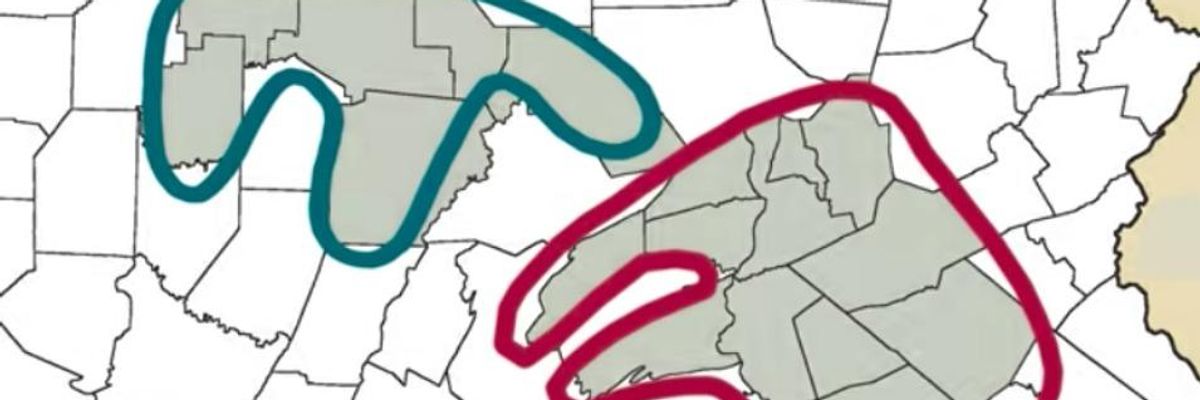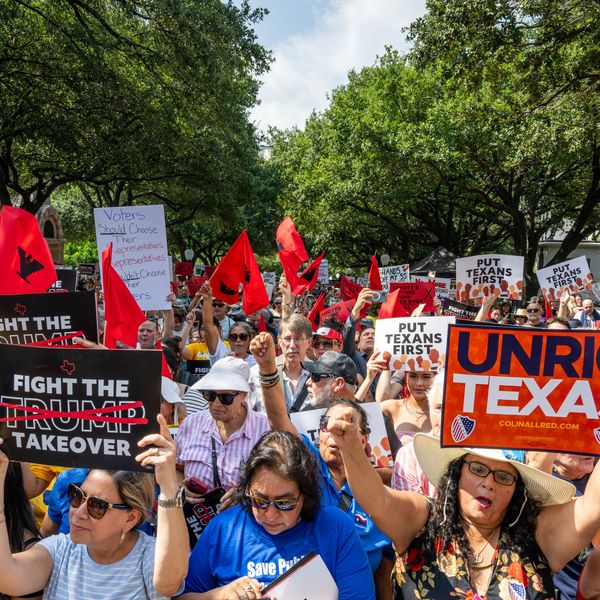
The Supreme Court will soon decide on the constitutionality of partisan gerrymandering. (Photo: Screenshot/RobertReich.org)
How to End Partisan Gerrymandering
"Unlike racial gerrymandering, partisan gerrymandering would seem to violate the First Amendment because it punishes some voters for their political views."
One of the biggest challenges to our democracy occurs when states draw congressional district lines with the principal goal of helping one political party and hurting the other. It's called "partisan gerrymandering."
Unlike racial gerrymandering - drawing districts to reduce the political power of racial minorities, which the Supreme Court has found to violate the Equal Protection Clause of the 14th Amendment - partisan gerrymandering would seem to violate the First Amendment because it punishes some voters for their political views.
In North Carolina in 2016, for example, Republicans won 10 of the state's 13 House seats with just 53 percent of the popular vote.
In the 2018 elections, because of partisan gerrymandering, Democrats will need to win the national popular vote by nearly 11 points to win a majority in the House of Representatives. No party has won this margin in decades.
So what can be done?
The Supreme Court will soon decide on the constitutionality of partisan gerrymandering. Hopefully, the Court will rule against it. But regardless of its decision, here are two other ways to abolish it:
First, state courts could rule against partisan gerrymandering under their state constitutions, as happened this year in Pennsylvania - where the state court invalidated a Republican congressional map that gave Republicans 13 out of 18 congressional seats even though the state is about evenly divided between Democrats and Republicans. The state court implemented its own map for the 2018 election, creating districts that are less biased in favor of Republicans.
Second, states can delegate the power to design districts to independent or bipartisan groups. Some states, like California, have already done this.
But if you want your state to end gerrymandering, you're going to have to get actively involved, and demand it.
After all, this is our democracy. It's up to us to make it work.
An Urgent Message From Our Co-Founder
Dear Common Dreams reader, The U.S. is on a fast track to authoritarianism like nothing I've ever seen. Meanwhile, corporate news outlets are utterly capitulating to Trump, twisting their coverage to avoid drawing his ire while lining up to stuff cash in his pockets. That's why I believe that Common Dreams is doing the best and most consequential reporting that we've ever done. Our small but mighty team is a progressive reporting powerhouse, covering the news every day that the corporate media never will. Our mission has always been simple: To inform. To inspire. And to ignite change for the common good. Now here's the key piece that I want all our readers to understand: None of this would be possible without your financial support. That's not just some fundraising cliche. It's the absolute and literal truth. We don't accept corporate advertising and never will. We don't have a paywall because we don't think people should be blocked from critical news based on their ability to pay. Everything we do is funded by the donations of readers like you. Will you donate now to help power the nonprofit, independent reporting of Common Dreams? Thank you for being a vital member of our community. Together, we can keep independent journalism alive when it’s needed most. - Craig Brown, Co-founder |
One of the biggest challenges to our democracy occurs when states draw congressional district lines with the principal goal of helping one political party and hurting the other. It's called "partisan gerrymandering."
Unlike racial gerrymandering - drawing districts to reduce the political power of racial minorities, which the Supreme Court has found to violate the Equal Protection Clause of the 14th Amendment - partisan gerrymandering would seem to violate the First Amendment because it punishes some voters for their political views.
In North Carolina in 2016, for example, Republicans won 10 of the state's 13 House seats with just 53 percent of the popular vote.
In the 2018 elections, because of partisan gerrymandering, Democrats will need to win the national popular vote by nearly 11 points to win a majority in the House of Representatives. No party has won this margin in decades.
So what can be done?
The Supreme Court will soon decide on the constitutionality of partisan gerrymandering. Hopefully, the Court will rule against it. But regardless of its decision, here are two other ways to abolish it:
First, state courts could rule against partisan gerrymandering under their state constitutions, as happened this year in Pennsylvania - where the state court invalidated a Republican congressional map that gave Republicans 13 out of 18 congressional seats even though the state is about evenly divided between Democrats and Republicans. The state court implemented its own map for the 2018 election, creating districts that are less biased in favor of Republicans.
Second, states can delegate the power to design districts to independent or bipartisan groups. Some states, like California, have already done this.
But if you want your state to end gerrymandering, you're going to have to get actively involved, and demand it.
After all, this is our democracy. It's up to us to make it work.
One of the biggest challenges to our democracy occurs when states draw congressional district lines with the principal goal of helping one political party and hurting the other. It's called "partisan gerrymandering."
Unlike racial gerrymandering - drawing districts to reduce the political power of racial minorities, which the Supreme Court has found to violate the Equal Protection Clause of the 14th Amendment - partisan gerrymandering would seem to violate the First Amendment because it punishes some voters for their political views.
In North Carolina in 2016, for example, Republicans won 10 of the state's 13 House seats with just 53 percent of the popular vote.
In the 2018 elections, because of partisan gerrymandering, Democrats will need to win the national popular vote by nearly 11 points to win a majority in the House of Representatives. No party has won this margin in decades.
So what can be done?
The Supreme Court will soon decide on the constitutionality of partisan gerrymandering. Hopefully, the Court will rule against it. But regardless of its decision, here are two other ways to abolish it:
First, state courts could rule against partisan gerrymandering under their state constitutions, as happened this year in Pennsylvania - where the state court invalidated a Republican congressional map that gave Republicans 13 out of 18 congressional seats even though the state is about evenly divided between Democrats and Republicans. The state court implemented its own map for the 2018 election, creating districts that are less biased in favor of Republicans.
Second, states can delegate the power to design districts to independent or bipartisan groups. Some states, like California, have already done this.
But if you want your state to end gerrymandering, you're going to have to get actively involved, and demand it.
After all, this is our democracy. It's up to us to make it work.

